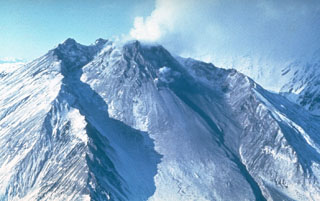Report on Bezymianny (Russia) — October 1994
Bulletin of the Global Volcanism Network, vol. 19, no. 10 (October 1994)
Managing Editor: Richard Wunderman.
Bezymianny (Russia) Seismicity at normal levels; steam plume as high as 1,000 m
Please cite this report as:
Global Volcanism Program, 1994. Report on Bezymianny (Russia) (Wunderman, R., ed.). Bulletin of the Global Volcanism Network, 19:10. Smithsonian Institution. https://doi.org/10.5479/si.GVP.BGVN199410-300250
Bezymianny
Russia
55.972°N, 160.595°E; summit elev. 2882 m
All times are local (unless otherwise noted)
Cloudy weather prevented observations on most days during the second half of September and October, but seismicity remained at normal levels. A gas-and-steam plume rose to 100 m above the volcano on 16 September, and to 1,000 m the week of 18-24 September. Activity was at normal levels the next two weeks. When conditions permitted, observers in Kozirevsk (~45 km WNW) saw a white steam cloud reaching 500-700 m above the crater on 13 October, 200 m on the 20th and 22nd, and 50 m on the 27th.
Geological Summary. The modern Bezymianny, much smaller than its massive neighbors Kamen and Kliuchevskoi on the Kamchatka Peninsula, was formed about 4,700 years ago over a late-Pleistocene lava-dome complex and an edifice built about 11,000-7,000 years ago. Three periods of intensified activity have occurred during the past 3,000 years. The latest period, which was preceded by a 1,000-year quiescence, began with the dramatic 1955-56 eruption. This eruption, similar to that of St. Helens in 1980, produced a large open crater that was formed by collapse of the summit and an associated lateral blast. Subsequent episodic but ongoing lava-dome growth, accompanied by intermittent explosive activity and pyroclastic flows, has largely filled the 1956 crater.
Information Contacts: V. Kirianov, IVGG; AVO.

